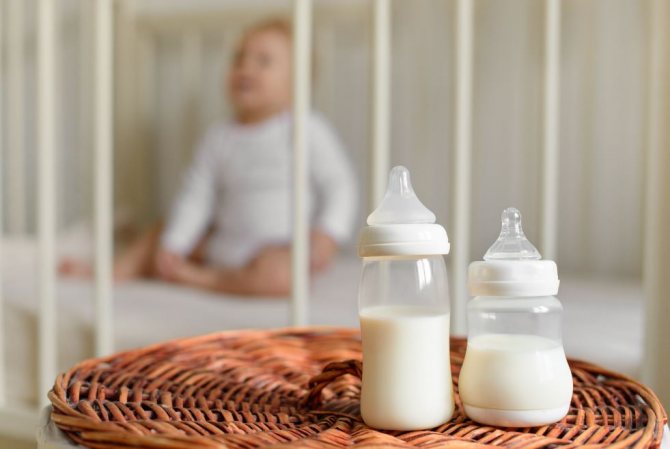23.09.2019 17331 0
What do pediatricians around the world agree on?
Excerpts from the “National Program for Optimizing Feeding of Children in the First Year of Life”
Breast-feeding
Mixed feeding
Artificial feeding
Regime and norms of nutrition for newborns
Formation of metabolism
The future health, physical and mental development of a newborn child depends on the nutritional status of a newborn child. While still pregnant, the mother, choosing a nutritious and varied diet for herself, had a beneficial effect on the development of the fetus and, of course, after its birth, she is ready to take care of the optimal diet and nutrition regimen for her baby. Medical scientists have conducted a number of studies to identify the relationship between nutrition in infancy and health status in adulthood in different population groups. As a result, the “Concept of Metabolic Programming” was formed and accepted by the medical community. Otherwise called the “Food Programming Concept”.
Features of feeding in the first days after birth
The long-awaited baby has finally been born, and although the parents have not yet had time to completely adapt to the new regime, they are already trying to make his life as comfortable as possible. Since in the first days after birth, requests are limited to sound sleep and a full stomach, mothers try to satisfy their needs to the fullest. As a rule, an infant expresses any dissatisfaction in the only accessible way - by crying. Parents perceive this as a signal of a lack of food. In fact, according to experts, hunger may be the least likely reason for babies to cry.
The baby's body adapts to life from the very first days. The stomach begins to rapidly increase. Therefore, the amount of food consumed is growing every day.
The amount of milk produced directly depends on the frequency of breastfeeding. In the first month of life after birth, when lactation is just establishing, it is very important to give the baby breastfeeding on demand, even if this happens often.
The baby does not yet have the strength to overeat, but he will be able to “pump” the amount of milk he needs. For the same reason, experts believe that early breastfeeding immediately after birth is necessary.
There is no clear and rigid norm for milk consumption established for everyone in the first days of a child’s life. In fact, the physiological needs of babies vary as much as any of their individual characteristics. The same applies to breast milk, the nutritional value of which is determined by the characteristics of the woman’s body.
At first, it is advisable for the baby to eat all the milk. The milk remaining in the breast signals the body that such quantities are not in demand. If the baby is full, but there is still milk, then it is better to express it. At first, feed the baby with only one breast so that the other has time to accumulate milk.
The amount of food a newborn consumes will depend on various factors. Nature prepares babies for the only acceptable nutrition in the womb. The sucking skill is inherent in every baby, but the degree of manifestation will vary depending on the child’s well-being or appetite. Sometimes physiological discrepancies, such as between the baby's mouth and the mother's breast, prevent adequate nutrition.
Many mothers are concerned about the fact that in the first days after birth the baby stops sucking too quickly. In fact, the child quickly fills up with colostrum, which is produced in the first days and which is much fattier and more nutritious.
The volume of food consumed directly depends on the volume of the baby’s stomach. A one-month-old baby has a stomach volume of no more than 10 ml. As the stomach enlarges, the baby's appetite will also increase. If in the first days the baby eats up a teaspoon of colostrum, then after a day he will need to drink 10 grams. By the time milk appears, the baby will eat up to 50 ml. On the fourteenth day after birth, the baby approaches 100 ml of nutrition.
Mixed feeding
Feeding a newborn baby is considered mixed if breast milk is combined with an adapted infant formula (supplementary feeding). This type of feeding can be used in cases where:
- the mother produces insufficient milk;
- Mom combines child care and work.
If a mother is worried that she does not have enough milk, she needs to consult a specialist on how to improve and restore lactation. If methods to improve lactation do not work, it is worth discussing with your pediatrician the introduction of supplementary feeding into the newborn’s diet and choosing the appropriate one. It is very important to give your baby breastfeeding until the last moment, even if there is very little milk. The mixture should be given after breastfeeding.
How to calculate how much your baby has eaten
If the child is bottle-fed, then calculating the amount of food consumed at a time is as easy as shelling pears. It is enough from what was, to take away what remains. However, breastfeeding mothers also want to know how much milk the newborn eats during one feeding. In this case, you will have to turn to the help of scales. It is better to use electronic ones, since they show the exact weight down to grams, and in the first days we are talking about them.
It is necessary to weigh the baby before eating, then feed and weigh again. The difference will be the amount of food consumed. Another option involves expressing milk. Already with a bottle it is easier to calculate how much the baby can drink.

It is very important to establish a feeding regime that is comfortable for everyone from the first days
It is important!
A mother should not worry that her child remained hungry, even if she put him to the breast 10 times, but it seems that he did not eat almost a drop. The size of a newborn's stomach is very small, so he eats only about 10 ml at one feeding. Thus, the baby can drink up to 100 ml throughout the day.
On average, milk comes in 3–4 days after birth and its quantity gradually increases. The baby's stomach also grows. This means that the amount of milk consumed also increases. So, on the first day a newborn can drink 10 ml per feeding, on the second day - 20 ml, and on the third day - 30 ml. But remember that each organism is individual and there are no strict limits here. However, if by the 4th–5th day of life the child’s body weight does not increase, but only decreases (by more than 8%), then this requires the attention of a specialist.
There is a popular way to determine the rate of breast milk consumption. You need to multiply the number of days that have passed since your birth by 10. But this method is inaccurate and has no scientific confirmation.
So how much should a newborn eat at one feeding? The table shows the daily and one-time volume of milk by month for children under 1 year.
| Child's age | Milk volume per feeding (ml) | Milk intake per day (ml) |
| 3–4 days | 20–60 | 200–300 |
| 1 Week | 50–80 | 400 |
| 2 weeks | 60–90 | 20% body weight |
| 1 month | 100–110 | 600 |
| 2 months | 120–150 | 800 |
| 3 months | 150–180 | 1/6 body weight |
| 4 months | 180–210 | 1/6 body weight |
| 5–6 months | 210–240 | 1/7 body weight |
| 7–12 months | 210–240 | 1/8–1/9 body weight |
Do not forget that breastfed children are introduced to complementary foods at approximately 6 months. This means that the amount of milk consumed is reduced, giving way to more mature food.

How much should a baby eat in the first 10 days of life?
The required amount of milk that a baby needs per day can be calculated in two ways.
- For children weighing less than 3200 g, the number of days lived is multiplied by 70. For example: A child is 6 days old and weighs 3050 g, then the daily volume will be 6x70 = 420 ml.
- In the second way, they expect to eat food for babies weighing more than 3200 grams. To do this, age in days is multiplied by 80.
To find out how much your baby eats at a time, you need to divide the daily volume by the number of meals. If this is 7 times, then 420:7 = 60 ml.
For example: A newborn is 5 days old and weighs 4 kg. The amount of food consumed per day will be 5X80=400 ml. This child eats 50 ml at one meal.
For children fed formula, the amount of food needed for one feeding is calculated by the formula: Number of days Yx10.
Features of breastfeeding
As a rule, the most difficult time when it comes to feeding is the first week after childbirth. At this time, mother and child are just learning to understand each other. But there is no doubt that breast milk is the best food for a baby. This product is naturally perfect and has everything you need at every step.
Breastfeeding is beneficial for both baby and mother:
- it helps the baby receive the substances necessary for growth, development and immunity and simply satisfy hunger;
- promotes active contraction of a woman’s uterus (under the influence of sucking movements) and a faster recovery process after childbirth.
Daily volume of formula for a baby from 10 days to a year
Mix rate calculation table
For example: the baby is 6 weeks old and weighs 4000 grams. He will need 4000:5=800 ml per day. If the child is 4 months old and weighs 6300, then he will need 6300:7=900 ml per day. Similar formulas are adapted for babies on artificial nutrition. Children fed on mother's milk are breastfed more often and therefore the amount of food may also be smaller.
Since the sucking reflex in newborns is well developed, they manage to eat more than they should. Therefore, experts often advise mothers to monitor their baby’s gains, since a weight increase of more than 350 grams per week indicates abuse of food, which can be fraught with other complications in the future.
What to do with sweets and allergenic foods during breastfeeding? Read our next article about how long it takes for food to pass into breast milk.
Duration of breastfeeding: How long should a newborn feed?
There are no time-based norms sufficient to saturate the baby, so the baby decides for himself when to let go of the breast. According to Dr. Komarovsky, a child's personality is reflected in the way they eat. On average, babies suckle calmly and become satiated within 10-12 minutes. However, some grab the nipple hastily, cannot cope with the gushing milk, and swallow a lot of air. Due to improper food intake, both air and milk are eventually regurgitated. Some children take the nipple limply and fall asleep without really eating.
Babies who are guzzling milk excessively should be stopped, removed from the breast after a couple of minutes of feeding, and allowed to release the air so they can continue to feed. Those who eat too sluggishly should be disturbed and not allowed to fall asleep. You can take the pacifier away and give it back frequently to help them remember to eat. It is best to teach such children to a diet.
Sometimes it seems that the baby is no longer suckling, but attempts to tear it off will not be successful, since the milk continues to flow to him. The baby can be applied to the other breast if one is already empty, but the baby continues to suck. Such manipulations will stimulate lactation, since the more the nipple is irritated, the more actively milk is produced.
It is extremely important not to interfere with the night intake of milk, since it is during this period that prolactin is produced, which promotes lactation and is responsible for the required volume of milk. If the baby receives the breast on demand, then you don’t have to worry about him going hungry.

Communication with your baby is now even more fun
Daily norms for artificial nutrition
To set standards for children on artificial nutrition, it is important to take into account the diet. Babies who eat formula need to be fed at least 8 times. If there are fewer meals, then you should increase the amount of food. The main thing to remember is that it is better to underfeed a child than to overfeed. It should be borne in mind that nutrition comes from the nipple better than from the mother's breast, and babies have excellent sucking skills. Usually the required measure is indicated on the packaging of the mixtures; just follow the instructions.
Feeding mode
For breastfed children, there is a rule - to put the baby to the breast on demand. Previously, it was believed that it was necessary to maintain an interval of 3 hours, but now pediatricians agree that breaks between feedings can be 1.5–2 hours. This does not mean at all that the baby will overeat.
Video: Does a child get enough food in the first months of life? Author: pediatrician, Ph.D. Komarovsky E.O.
The duration of one feeding is usually 15–30 minutes. Although there are deviations from the norm. For example, a woman has a lot of milk, and the baby is full in 5–10 minutes. Or, on the contrary, little milk comes in, and the baby can suck out the rest for a long time. Some babies simply like the process of sucking and use their mother's breast as a pacifier.
Features of nutrition during artificial feeding
Sometimes the baby may consume less formula than he should. This is par for the course. Usually the deficiency is corrected at the next feeding. It should be taken into account that in the digestive system of a baby, formula is processed somewhat more slowly, so breaks between meals during the day can reach three hours, and at night it is better to wait up to 6 hours.
The main thing, after finishing feeding, is to help the baby burp the air swallowed during the meal. If the baby has not eaten the prepared mixture completely, then you can supplement it after a certain period of time.
What to do if your newborn is malnourished?
If the baby still does not have enough mother’s milk, then you should first take care of a more intense flow of milk, or supplement it with formula. Lactation can be stimulated if:
- Put the baby to the breast more often;
- Increase the amount of fluid consumed;
- Turn the feeding process into a relaxing pastime.
Some women tend to eat fatty foods to increase the fat content of their milk. However, this way the quality will not change.
The fat content of milk depends on the individual characteristics of the woman. Eating special foods can only lead to mom's weight gain. It is necessary to ensure that a nursing woman eats properly and in a balanced manner.
The food contained essential microelements that are required not only for the mother herself, but also for the proper development of the baby.
Only through the mother's nutrition can the child receive the necessary proteins, fats and carbohydrates. You should follow your doctor's recommendations regarding the prohibition of certain food groups. In order not to harm the baby, it is important to exclude spicy, fried, smoked foods.
Citrus fruits are also prohibited for a nursing mother, and in general all allergenic products, even honey and eggs. At the very least, they should be used carefully and monitor the effects on the baby.











